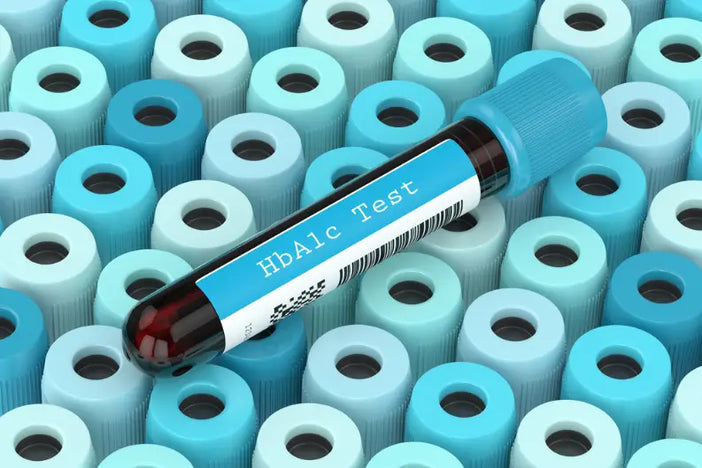HbA1C - diagnosing diabetes

Diabetes is a mathematician’s diagnosis. You always have to know your blood sugar levels and what nutritional regimes to follow (or how much insulin to take) to keep it balanced out. Regular testing is critical.
This includes home glucometer testing throughout the day, as well as periodic trips to the doctor’s office, for an HbA1C test. The first provides you with a snapshot of your glucose levels in the here and now, while the second shows an average of your blood sugar levels over the course of two to three months. HbA1C checks are also used by doctors to keep track of diabetes care plans. HbA1C tests are recommended by the American Diabetes Association (ADA) for diagnosing prediabetes, type 1 diabetes, and type 2 diabetes. It is called the HbA1C test, hemoglobin a1c test, glycohemoglobin test or glycated hemoglobin test.
What is HbA1C in a nutshell?
The hemoglobin A1C test, otherwise known as HbA1C test or simply A1C, is used to diagnose:
- Prediabetes - indicates a higher risk for diabetes;
- Type 1 and type 2 diabetes -diagnosing and confirming the type of diabetes;
- Monitor your diabetic treatment - to determine whether your course of diabetes treatment is working, or if your diet and medications need to be adjusted.
What is hemoglobin?
A protein that carries oxygen throughout your body is called hemoglobin (Hb), it is stored in red blood cells. Sugar is processed by our bodies and it binds or sticks to hemoglobin, this combination is called glycated hemoglobin. This essentially serves as a glucose tracker that is easily detected by the hemoglobin a1c test. As a result, measuring glycated hemoglobin, also known as HbA1C, can be used to reflect average blood glucose levels over time. This gives you a good idea of how well your blood glucose is regulated over time.“If glucose levels remain high, glucose interacts with body proteins to cause damage,” explains Dr. Sarah Brewer, member of our advisory board. “This is the basis of the HbA1c blood test, which measures levels of glycosylated hemoglobin (how much glucose is bound to the hemoglobin in your red blood cells). This glucose-inflicted damage can affect large arteries by hastening hardening and furring up the arteries (atherosclerosis) to cause what is known as the macrovascular (large blood vessel) complications of diabetes:
- angina and heart attack;
- stroke;
- peripheral arterial disease or PAD (pain in the legs on walking due to poor blood circulation; this can lead to ulceration) “.
What happens during the hemoglobin A1c test? Does it require preparation?

To test hemoglobin a1c levels, a health care professional will take a blood sample from your vein. The hemoglobin a1c test does not require any special preparations, it usually takes a couple of minutes to do it. The HbA1c test will eliminate day-to-day variability in glucose levels, as well as the need for them to fast and make dietary preparations beforehand. Is it possible to test HbA1C at home? Yes, indeed. It is possible to test HbA1C at home. Unfortunately, it is uncommon, costly, and unnecessary if you are being closely monitored by your doctor.
HbA1C – what do the test results mean?
HbA1C results are expressed in percentages. Some average values are:
- Normal - hemoglobin A1C below 5.7%;
- Prediabetes - hemoglobin A1C between 5.7% and 6.4%;
- Diabetes - hemoglobin A1C 6.5% or higher.
Because high levels of glycosylated hemoglobin can cause such serious complications in diabetics, you must understand and know your HbA1C test results. Taking measures to restore them to the normal range, is crucial if needed.
What is a normal HbA1c for diabetics? What is a good HbA1c level for type 2 diabetes?
If you have diabetes, an optimal HbA1C level is 48 mmol/mol (6.5%) and any value below 7% is considered good. This is valid for people managing their diabetes with diet and exercise. As well as for diabetics taking necessary medication, like metformin.
If you have not been diagnosed with type two diabetes higher hemoglobin A1C level (50 mmol/mol or greater) can indicate that you have type two diabetes. An ideal target or range of HbA1C levels varies. It depends on your age, other health conditions, and risk of hypoglycemia (low blood glucose) but always consult with your healthcare professional on the recommended individual hemoglobin A1C levels. You should check your hemoglobin A1C levels every three to six months. The HbA1C level only shows your blood glucose level over that time because red blood cells only last for about 4 months or 120 days.
What are the benefits of lowering your hemoglobin A1C levels?

In both type 1 and type 2 diabetes, several studies have shown that reducing A1C levels can help delay the progression of diabetes and reduce the risk of complications including nerve damage and cardiovascular disease. Also, minor changes in hemoglobin A1C levels can have a big impact. For people with type one and type two diabetes lowering the HbA1c level by 1% reduces the risk of microvascular complications by 25%.
When to wait with doing the hemoglobin A1C test?
To help avoid or postpone long-term, severe health issues, it is important to keep your average blood sugar as close to your target range as possible. Everyone is different, in certain cases, HbA1C cannot be used to diagnose diabetes. Your health care provider can recommend you not to measure hemoglobin A1C considering that a lot of things can cause your A1C levels to change. Misleading results can occur in case you have:
- pregnancy
- anemia
- high cholesterol levels
- kidney disease
- liver disease
- taken vitamin C and E
As an alternative, an Oral glucose tolerance test (OGTT) can be used.
Glucose based criteria for the diagnosis of diabetes
To be diagnosed with diabetes, you should match one of the following criteria:
- Experience common symptoms of diabetes like increased thirst, frequent urination, and unexplained weight loss. A blood sugar level equal to or higher than 200 milligrams per deciliter (mg/dL). This type of test is done at any time, without regard to your food intake. This test is also called a random plasma glucose test or random blood sugar test.
- Have a two-hour oral glucose tolerance test (OGTT). The result is equal to or higher than 200 mg/dL. This kind of test is usually used for gestational diabetes testing.
- Have a fasting blood sugar level that is equal to or higher than 126 mg/dL. A fasting blood sugar test or fasting plasma glucose test(FPG) is done after not eating or drinking anything but water for 8 hours. This is the preferred method for diagnosing diabetes because it is less expensive, convenient, and easy to do.
- Get test results with levels that are 6.5% or higher on the HbA1c test. This kind of test is usually not recommended for testing diabetes in children or pregnant women.
Can exercise and diet help to lower A1C levels?
- Blood glucose levels, and therefore hemoglobin A1C levels, can be managed by physical activity, diet, and medication. So make sure to:
- Respect the treatment. Consistent use of medications and lifestyle changes as your doctor prescribed can help you reach lower A1C levels.
- Regular blood glucose monitoring is important to ensure that the individual achieves their goals and makes any necessary adjustments.
- Physical activity. According to current recommendations, adults should engage in about 150 and 300 minutes of moderate physical activity each week. Insulin users should discuss a suitable plan with their doctor.
- Get professional help for your dietary needs. Each person's nutritional requirements, including the number of carbohydrates they can eat, are individual. Make sure to consult with your doctor on potential dietary changes.
- Consider a workout. Exercising is important.
- Tracking progress is beneficial for self-motivation, tracking improvements, and determining the techniques that function best for a specific person. Keep a journal of food, medication, and exercise.
- Get your family and friends involved. It is much easier to stick to a new lifestyle if you have someone to inspire you and keep track of your success.
Every day, people around the world connect in our active community to share advice, get support, and help each other live a healthier fuller life, despite their chronic conditions. It is a movement changing lives across the globe. Join our Facebook Community Group here.



